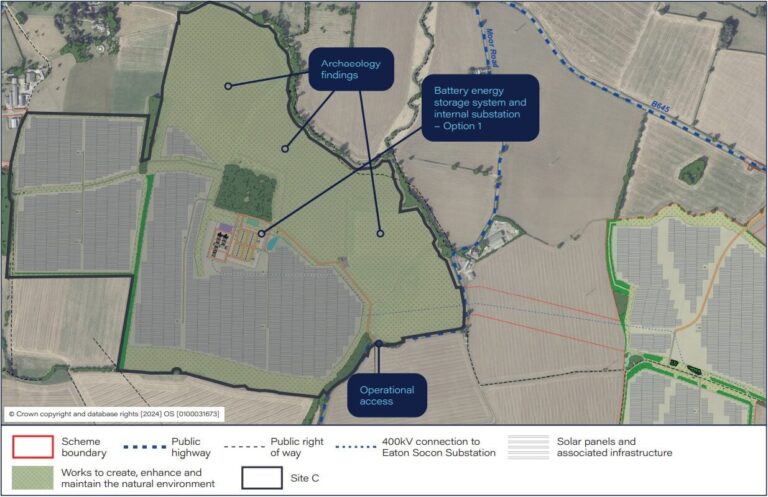British developer Brockwell Solar and Storage, formerly RNA Energy, has opened regulatory consultations for a proposed solar and battery storage development north-west of St Neots, on the Cambridgeshire-Bedfordshire border.
The East Park development would include a ground-mounted solar photovoltaic power plant with a capacity of 400 MW and a 100 MW battery energy storage system (BESS). The development will include an on-site substation and will be connected via underground cable to the existing electricity transmission network at National Grid’s Eaton Socol substation.
If the proposals are approved, developers say construction would begin in 2027. This round of consultation follows a non-statutory consultation last year, the feedback from which helped inform the development of the proposals now being examined.
A major change to the plans, which are spread over four sites and will cover 776 hectares, is the removal of what Brockwell has called a ‘significant parcel’ of land from the proposed Site C. This is the result of archaeological research that identified the area as the likely location of a previously unknown small Roman town.
The second proposal also relocated the BESS and its substation; Last year it was proposed for an area within Site C, but in response to feedback and environmental studies a second option has been proposed, which would see it placed in Site D. Both options are open for consultation.
Brockwell will create, improve and maintain the surrounding local environment, aiming for a net gain of at least 10% in biodiversity. The developer is hosting a series of public consultation events in the area, with feedback available until October 29.
Local resistance to the development of solar energy
Like many large-scale solar projects planned in Britain, East Park has faced significant local backlash. Concerns include the size of the project, the loss of high-quality agricultural land and the visual impact.
While the group campaigning against the development calls its size “excessive and literally overwhelming”, the solar PV plant’s generating capacity and land use area are lower than Island Green Power’s recently approved Cottam Solar Project.
According to the consultation brochure, Brockwell understands the concerns about development, but notes the importance of solar development to the legally binding net zero target by 2050, and also cites the Labor government’s target to triple solar capacity by 2030 .
It is widely expected that solar energy generation will not occur in locations with high quality agricultural land, but this is also a common counterpoint raised by communities. Energy Secretary Ed Miliband, who will ultimately decide the fate of East Park when it is referred to central government for a development consent order (DCO), has promised that the government will proceed “not on the basis of myths and false information, but on basis of evidence”.
Citing estimates that ground-mounted solar would take up 0.1% of UK land by 2022, he said his decision to grant DCOs for three large solar farms was supported by the National Farmers’ Union (NFU ).


